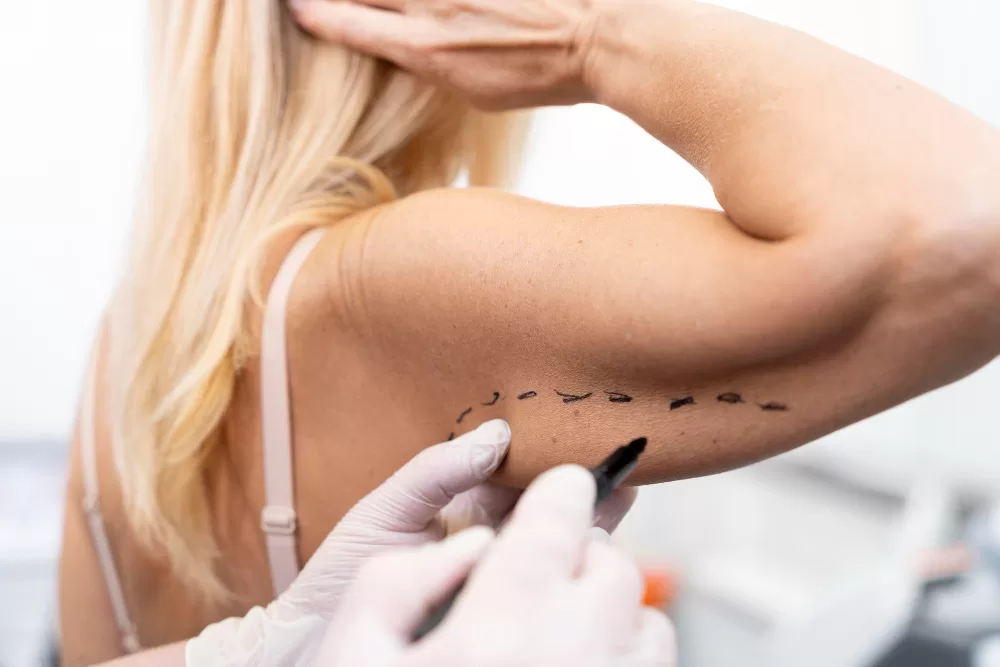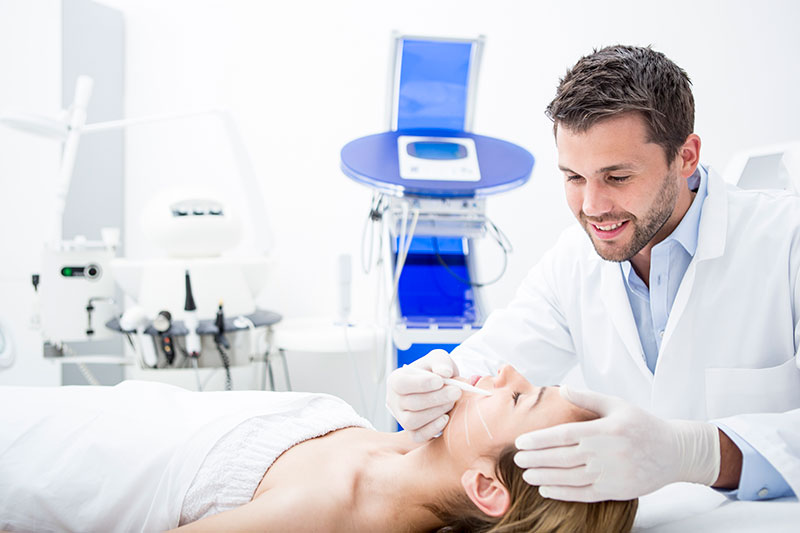
Arm Lift
If you are tired of constantly hiding your arms behind long sleeves and sweaters, then you’ll be excited to learn more about the incredible, life-changing solution that awaits you in Turkey. With our innovative and effective arm lift surgery, you can say goodbye to saggy skin and hello to beautifully defined, toned arms that will make you feel confident and proud. Imagine being able to wear tank tops, summer dresses, and sleeveless tops with complete confidence and happiness. That’s the kind of transformation that arm lift surgery can provide. Our expert team of professionals is dedicated to providing you with the highest level of care and attention, ensuring a smooth and successful experience every step of the way. Don’t let your arms hold you back any longer – take the next step towards a brighter, more confident future with arm lift surgery in Turkey.
How much does it cost?
The average arm lift cost Turkey ranges from €2950 to €3250, but some factors increase the arm lift surgery cost Turkey.

Say Goodbye to Saggy Skin: Unveiling the Power of Arm Lift Procedures
The life-changing solution that will banish those bat wings and unleash your inner confidence. Welcome to the world of arm lift surgery, where saggy skin becomes a distant memory and your dream of perfectly defined arms becomes a reality.
Understanding Arm Lift Surgery
Have you ever wondered what exactly an arm lift entails? An arm lift, medically referred to as brachioplasty, is a surgical procedure designed to address concerns related to the appearance of the upper arms. It is specifically tailored to combat sagging skin, excess fat deposits, and lack of muscle definition in this area.
During the natural aging process, as well as after significant weight loss, the skin loses its elasticity, causing it to droop and hang loosely. This can create the dreaded “bat wings” effect, making many individuals feel self-conscious about their arms. Unfortunately, exercise and diet alone often cannot fully address these concerns, as they primarily target fat reduction and muscle toning rather than skin tightening.
Who is a good candidate?
Wondering if you might be a suitable candidate for an arm lift? Generally, individuals who benefit most from this procedure share some common characteristics. They may:
- Have excess, loose skin in the upper arm area due to aging, weight loss, or genetic factors.
- Experience dissatisfaction or self-consciousness about the appearance of their arms.
- Have relatively stable body weight and realistic expectations about the outcomes of the surgery.
It’s important to note that arm lift surgery is not intended for weight loss purposes but rather for sculpting and contouring the arms. Consulting with a qualified plastic surgeon is crucial, as they can evaluate your specific situation, discuss your goals and concerns, and determine whether you are a suitable candidate for the procedure.
How is the procedure performed?
Now that you understand the purpose of an arm lift and the type of candidates it benefits, let’s explore how the surgery is typically carried out. The procedure itself involves several key steps:
- Anesthesia: Before the surgery begins, you will be administered anesthesia to ensure your comfort throughout the procedure. The type of anesthesia used may vary, and your surgeon will discuss this with you during the consultation.
- Incisions: Once you are under anesthesia, your surgeon will strategically make incisions in the targeted areas of the upper arms. The location and length of these incisions may depend on the extent of correction required and the specific technique chosen
- Tissue adjustment: Through the incisions, your surgeon will remove excess skin and, if necessary, address underlying fat deposits. They will also tighten and reshape the underlying supportive tissues to create a more defined and youthful arm contour.
- Incision closure: After the necessary adjustments have been made, the incisions are carefully closed with sutures, and the surgical area is bandaged to facilitate healing.
Recovery and results
Following arm lift surgery, a proper recovery period is crucial to ensure optimal healing and desirable outcomes. You can expect some swelling, bruising, and discomfort in the days following the procedure. Your surgeon will provide detailed post-operative instructions, including pain management techniques, wound care, and guidelines for physical activity.
Over time, as your body heals and the swelling subsides, you will begin to notice the remarkable transformation of your arms. Excess skin will be eliminated, revealing smoother, tighter contours. The newfound confidence that accompanies your toned arms will allow you to fully embrace sleeveless tops, dresses, and swimsuits without hesitation.
Consultation and planning
Before undergoing an arm lift procedure, it is essential to schedule a consultation with a qualified plastic surgeon. During this initial meeting, you will have the opportunity to discuss your concerns, goals, and expectations. The surgeon will evaluate your arms’ condition, considering factors such as skin elasticity, fat distribution, and muscle tone. They will also take your overall health and medical history into account to ensure your safety during the procedure.
Together with your surgeon, you will create a customized treatment plan tailored to your specific needs. They may use computer imaging to provide a visual representation of the potential results, helping you visualize the transformation that can be achieved with an arm lift.
Surgical techniques
There are different surgical techniques employed in arm lift procedures, and the specific technique chosen will depend on your unique situation. The two primary techniques used are:
- Traditional Arm Lift: This technique is suitable for individuals with a significant amount of excess skin and fat in the upper arms. It involves an incision extending from the underarm to the elbow, typically on the back or inner side of the arm. This allows for maximal removal of excess tissue and reshaping of the arm contours.
- Minimal Incision Arm Lift: Also known as a mini arm lift, this technique is ideal for patients with mild to moderate skin laxity and fat deposits. It involves smaller incisions, usually located in the underarm area or along the upper arm’s inner side. The mini arm lift is less invasive and may be combined with liposuction to achieve optimal results
Anesthesia and incisions
Arm lift surgery is typically performed under general anesthesia, ensuring that you are completely asleep and comfortable during the procedure. Your anesthesiologist will discuss the anesthesia options with you and determine the most suitable approach based on your medical history and the surgeon’s recommendations.
Once you are under anesthesia, your surgeon will proceed with making incisions. The location and length of the incisions will depend on the chosen technique and the extent of correction required. The incisions are carefully planned to be discreetly placed, minimizing visible scarring.
Removal of excess skin and fat
With the incisions made, your surgeon will meticulously remove the excess skin and, if necessary, address underlying fat deposits. They will skillfully sculpt and reshape the arm’s contours to create a more aesthetically pleasing and proportionate appearance. Liposuction may be performed concurrently to further enhance the arm’s definition by removing excess fat.
Closing the incisions and recovery
Once the desired adjustments have been made, your surgeon will close the incisions using sutures. In some cases, absorbable sutures may be used, eliminating the need for suture removal later on. The incision sites are then covered with surgical dressings to protect them during the initial healing period.
Following the arm lift procedure, you will be closely monitored in a recovery area as the effects of anesthesia wear off. Your surgeon will provide specific post-operative instructions, including details on pain management, wound care, and activity restrictions during the recovery period. It is crucial to follow these instructions diligently to promote proper healing and achieve optimal results.
Risks and Considerations
While arm lift surgery can yield transformative results, it’s important to be aware of the potential risks and considerations associated with the procedure. Understanding these factors will help you make an informed decision and ensure your safety and satisfaction. Here are some key points to consider:
- General risks of surgery: As with any surgical procedure, arm lift surgery carries general risks, including adverse reactions to anesthesia, bleeding, infection, and poor wound healing. These risks can be minimized by choosing a qualified and experienced plastic surgeon, following pre- and post-operative instructions diligently, and maintaining open communication throughout the process.
- Scarring: Arm lift surgery involves incisions, which will result in permanent scars. The size and visibility of the scars will vary depending on factors such as incision technique, individual healing factors, and post-operative scar care. While surgeons strive to minimize scarring and place incisions strategically, it’s important to have realistic expectations about the presence of scars.
- Swelling and bruising: It is common to experience swelling and bruising in the treated area following arm lift surgery. These effects are temporary and should gradually diminish over time. Proper post-operative care, such as elevation of the arms, wearing compression garments, and following your surgeon’s instructions, can help minimize swelling and bruising.
- Numbness and sensory changes: Temporary numbness or altered sensation in the arms is common after arm lift surgery. This is typically due to disruption of sensory nerves during the procedure. Sensation often returns gradually over several months as the nerves heal. However, in some cases, there may be permanent changes in sensation.
- Poor wound healing and complications: In rare cases, complications such as poor wound healing, infection, or excessive scarring may occur. It is crucial to closely follow your surgeon’s post-operative instructions to minimize these risks. Should any concerns arise during the healing process, promptly contact your surgeon for guidance and support.
- Potential for revision surgery: While arm lift surgery aims to achieve optimal results, there may be cases where additional procedures or revisions are necessary to address specific concerns or achieve desired outcomes. Your surgeon will discuss the possibility of revision surgery during your consultation and ensure you have realistic expectations about the potential need for additional procedures.
- Considerations for weight management: It is important to understand that arm lift surgery is not a weight loss procedure. While the surgery can remove excess skin and fat, it is not a substitute for maintaining a healthy lifestyle. To preserve the results and enjoy long-term benefits, it’s crucial to maintain a stable weight through proper diet and regular exercise.
As with any surgical procedure, it’s vital to consult with a qualified and experienced plastic surgeon who can thoroughly assess your individual case, discuss potential risks, and provide personalized recommendations. Open and honest communication with your surgeon is key to ensuring your expectations align with the possibilities and limitations of arm lift surgery.
In conclusion, by understanding and considering the potential risks and factors associated with arm lift surgery, you can make an informed decision about pursuing the procedure. Stay informed, ask questions, and work closely with your surgeon to achieve the best possible outcomes for your arm transformation.






